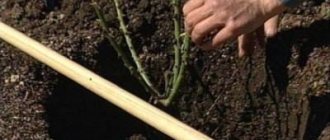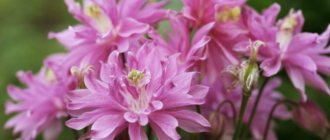Phlox paniculata variety Peppermint Twist
No matter how many new phlox products appear, fans of this flower still can’t get enough, but the Dutch have already promised yellow, green, and even double ones. We are waiting for them. But we still love the usual two-color phloxes.
Phlox appeared in Russian gardens more than 200 years ago. “Flame flower” – this is how the name of the plant is translated from Greek; it immediately fell in love with the Russian soul. It blooms generously, is frost-resistant and hardy in difficult conditions.
From 50 species and 1500 varieties, each gardener will choose his own phlox. Most plant species are perennials .
Diseases and pests
Phloxes are not threatened by diseases if you take good care of them and do not neglect your planting.
One of the most common diseases that spoils the appearance of this perennial is powdery mildew, which covers the leaves and stems with a white coating. This disease can overcome the plant in mid-July. If no action is taken, the diseased leaves will begin to dry out and fall off. To avoid this disease, plants must be treated with one percent Bordeaux mixture or copper sulfate solution of the same concentration in October. At the beginning of summer, spray the plants with fungicidal preparations.
If you notice signs of the disease, namely a white coating, then the plants must be treated with Bordeaux mixture. Repeated treatment is carried out after 7-10 days.
In addition, aphids are dangerous for plants, but they only attack weakened flowers. Therefore, avoid lack of nutrition and water them on time. Among the pests of phlox, earwigs, spider mites, and wireworms should also be noted.
As you can see, this beautiful perennial plant does not cause any particular difficulties in care and will not require much attention from you. At the same time, these bright, fragrant flowers can become the best decoration of the garden and a wonderful addition to your flower arrangement. They are very unpretentious, but they bloom very luxuriantly and profusely, especially if you feed them.
Phlox Nicky: care and reproduction
First of all, it is worth touching on the topic of plant care. Those who decide to acquire this flower must understand how to care for it, otherwise it will die almost immediately after planting. First of all, it is worth considering the fact that the flower loves an increased level of moisture. Due to the fact that thin processes of the root system, as a rule, are not located too deep in the soil (up to 15 cm), in no case should the soil be allowed to dry out completely. In addition, lack of moisture can negatively affect flowering. The flowers will become smaller and more lethargic. It is considered optimal to water the plant every morning with 1.5-2 buckets.
It is important not to “let go” of the flower bed where Nicky phlox grows, since along with the appearance of weeds, the chance of developing various diseases and the appearance of pests also increases. With the arrival of the first frost, it is necessary to cut the bush to the very root, and treat the remaining root well with copper sulfate
Cut stems must be disposed of. Gardening experts do not recommend thickening the bushes to avoid the plant being affected by powdery mildew.
As for the methods of its reproduction, the situation here is a little more complicated. The easiest way to propagate is by separating part of the roots from the mother plant. This should only be done in early autumn or spring, because it is at this time that young shoots begin to emerge from the soil. As a rule, the division has several well-formed stems, which should be planted to a depth of no more than 4 cm.
You can also propagate this plant variety using cuttings. Propagation material should be dug up in early summer. The cuttings take root quite quickly (no longer than 30 days).
The method of rooting layering is less commonly used. This means that the stems should be bent straight to the ground and anchored to the ground. Then the hilling procedure is carried out with a mixture of humus and peat, and in the fall a full-fledged bush will grow from the resulting workpiece.
It is worth mentioning the propagation of the plant by planting phlox “Niki” seeds. This requires stratification without fail. Exactly one month before planting the plants in open areas, the seeds must be planted in seedling boxes. The best time for this procedure is considered to be the last weeks of May. The soil must also be prepared in advance: dug up, cleared of weeds, treated with fertilizers and moistened.
For more information about this phlox, see the following video.
Planting methods
Annual phloxes can reproduce by self-sowing, but for perennials it is easier to choose cuttings
There are several ways to propagate phlox:
- seeds,
- cuttings,
- dividing the bush,
- layering.
The choice of option depends on when the grower plans to carry out the “operation”. Dividing the bush (it should be 4–5 years old) is best done in early spring, this gives the plant a good chance of rooting. If absolutely necessary, this can be done in early autumn, but only when the phloxes have finished flowering.
The plant is propagated by layering throughout the season, including in summer.
Propagation by cuttings (experts consider this method the most convenient) is carried out in the spring, when the soil has warmed up well enough, or in September, without waiting for the first frost, so that the phlox can prepare for the cold and take root firmly. The summer option of propagation by cuttings is chosen by those gardeners who visit their plot regularly, and not on visits - if the plant is not watered even for 2-3 days, it may die.
Sowing of seeds is carried out taking into account climatic conditions. If you sow planting material in open ground, daytime temperatures should not fall below +20°C, and night temperatures +12°C. It is possible to sow seeds before winter (in October - November), in this case the soil should be frozen, and the seeds should be covered with dry soil, excluding watering.
When growing seedlings at home, use disposable containers with drainage holes. Here's how to do it step by step:
- Purchase universal soil for seedlings from a specialized store (it is better if it contains vermicompost).
- Fill the soil into disposable containers to about 2/3 of their volume and level it.
- Disinfect the soil with a solution of phytosporin.
- The seeds are laid out on the surface of the soil and sprinkled with soil on top.
- Cover the containers with lids or spunbond, take them outside, place them on the ground, under the snow, so that the seeds undergo natural stratification within a week.
- The containers are returned to the house and the seedlings are grown in the usual way for flower crops, at an average temperature of +21°C.
There are other ways to grow phlox seedlings. For example, you can do this: soak the seeds and keep them moist for 2 weeks at room temperature (18 to 22°C). After this, add clean dry sand to the seeds, mix and place in the refrigerator for a week to undergo stratification. Then the planting material should be added to disposable containers, buried 1 cm into the soil.
For good development of seedlings, it is necessary to maintain a temperature regime in the range of +17...25°C.
Phlox will be ready for planting in open ground after they have 5-6 true leaves, and also if the threat of frost has passed outside.
The place must be completely ready for planting - loosened soil, abundant watering. Plants should be planted at a distance of half a meter from each other, since the phlox will have to spend several years in this place and for them, having grown, the crowded space will become disastrous.
Varieties of splayed phlox
The color of the spreading phlox varieties, in contrast to the paniculata one, is not very diverse: it is a range of white, sky blue, and lilac tones. However, even these colors make it possible to create very beautiful flower beds. For this, flower growers use popular varieties that are cultivated.
Spreading Chattahoochee Phlox
Phlox Chattahoochee is a variety with soft lilac flowers. The bushes are compact, low-growing: up to 25 cm. Flowering begins at the end of May and continues until the last ten days of June. The flowers are five-petaled, up to 4 cm in diameter. It is advisable to grow the crop in semi-shaded places.
The lilac-pink core gives the flowers of the spreading phlox a special attractiveness. Attention! This variety has good drought resistance. Suitable for beginner gardeners.
Spreading Phlox Variegata
The Phlox Variegata variety produces light lilac flowers up to 2–2.5 cm in diameter. The leaves are variegated, with a dark green core and light yellow edging. Forms dense thickets that tightly cover the soil, the maximum height of peduncles is 15 cm.
Variety Variegata has attractive pale lilac flowers
Spread phlox Clouds of Perfume
The Phlox Clouds of Perfume variety is a low shrub up to 30 cm. The flowers are bluish, lilac. They give a pleasant aroma, which is why the variety got its name, which can be translated as “clouds of perfume.”
Important! The variety is characterized by moderate winter hardiness: it can withstand frosts down to -29 °C. Therefore, it is grown only in the middle zone, in the Black Earth Region and the southern regions of Russia.
The Clouds of Perfume variety is characterized not only by beautiful flowers, but also by a pleasant aroma
Spread Phlox White Perfume
Phlox splayed White Perfume has white flowers up to 2 cm in diameter with a delicate “perfume” aroma. The bush is quite tall - up to 40 cm. The leaves are narrow, up to 5 cm in length, hard. The variety loves moisture - during drought its flowering is reduced.
White flowers of White Perfume create a pleasant spring background in the flowerbed and in mixborders
Spread Phlox Blue Moon
Phlox Blue Moon is a variety whose name translates as “blue moon”. The bush is small, up to 20 cm in height, and the inflorescences are large: up to 4 cm in diameter. They emit a very pleasant aroma. This variety of spreading phlox (pictured) has flowers an attractive blue.
The Blue Moon variety is often used in single plantings on well-kept lawns.
Spreading Phlox Blue Dreams
The Phlox Blue Dream variety is a well-growing bush with lavender-blue, light lilac flowers. Grows up to 30 cm, completely covers the soil.
Delicate lilac flowers of the Blue Dreams variety exude a pleasant aroma
May Breeze
Phlox May Breeze (“May Breeze”) is a plant up to 40 cm high. It produces soft lilac, bluish flowers up to 5 cm in diameter. They give a pleasant “spring” smell. The May Breeze variety looks good in mixborders; it is often used for planting near a pond and in rock gardens.
Spread phlox May Breeze withstands winter frosts down to -34 °C
Fullers White
The Phlox Fullers White variety is a snow-white flower with a diameter of up to 3 cm. It gives a very pleasant honey aroma, which distinguishes this variety from the rest. Suitable for both garden decoration and cutting.
The advantages of the spread phlox Fullers White - snow-white flowers with a honey aroma and pleasant juicy greenery
Digiro Ice
Phlox Dirigo Ice is one of the light varieties. The flowers are an unusual pastel blue, cream shade. At the same time, the foliage is light green, which creates a very pleasant combination.
The Digiro Ice variety looks very elegant thanks to its original color scheme
Montrose Tricolor
Gardeners love this variety of spreading phlox, Phlox Montrose Tricolor, for its lavender flowers with a purple center. The stems are flexible, thin, and spread along the ground. Not only the inflorescences are decorative, but also the leaves: they are painted in a rich green color, have a white edge with shades of soft pink. That is why the variety received the name “Tricolor”. The combination of three shades at once creates a kind of “exotic” atmosphere.
The Montrose Tricolor variety is used both for garden decoration and for cutting
Rules for creating flower borders
A flowering border , which will delight the eye throughout the summer season, is formed from several types of plants. Small-bulbous and bulbous the first to bloom in spring .
They are planted closer to the edge of the path, followed by a strip of herbaceous plants that bloom in summer. Low-growing crops that will bloom in the fall are placed along the outer perimeter of the border.
Now in more detail :
- In the first row bulbous perennials are planted - crocuses, snowdrops, hyacinths, daffodils, tulips. The path will also be decorated with ground cover creeping plants - phlox , periwinkle , grass carnation . Here you can plant peppermint and spearmint, thyme , and basil. Fragrant herbs grow quickly and are used as spices;
- The middle- height row of roadside ridges is filled with low-growing perennial flowers . Hosta , bergenia , matricaria , and chrysanthemum are suitable for these purposes . Unpretentious perennial plants will cover the departed primroses with their leaves and shoots;
- The completion of the border composition will be low-growing ornamental shrubs - border rose , garden lingonberry Japanese spirea barberry . Their height should not exceed 40 cm so as not to obscure the view of the flower beds and landscape compositions on the site.
When decorating a border, you should select plants according to color scheme . It can be designed in shades of the same color or in contrasting combinations. To ensure that the harmonious lines of the pattern are not interrupted, the plants are planted close to each other.
Phlox after flowering
Annual phlox may bloom next year, but the quality of the inflorescences is unlikely to be high. Therefore, collect the seeds if you want, cut off the tops that have dried in the fall, and dig up the soil on the site, removing the phlox rhizomes from it. In the spring, you can sow the collected seeds, and the flowers you like will bloom again.
In the photo: Phlox blooming in the garden
Wintering phlox
Perennial phloxes, or rather, their growth buds, can freeze out in a snowless winter if the temperature drops to -10-15 ºC, and if the frost reaches -20-25 ºC, the rhizome of the phlox will die. Therefore, in the fall, after the phlox tops have turned yellow and dried out, cut them off and sprinkle the root collars with a layer of soil with peat. Cover them with straw, fallen leaves or spruce branches to keep the rhizomes in the ground until spring. If snow falls 50-60 cm thick, then you don’t have to be afraid of thirty-degree frosts.
Review of types and best varieties
In landscape design and gardening, both artificially obtained forms and varieties of phlox, as well as their wild species, are popular. Selection work with many natural types of phlox continues to this day.
Paniculate phlox is one of the most famous representatives of its genus. The natural habitat of this herbaceous perennial is southeastern North America. In the wild, the plant prefers to grow in places with well-moistened soil - in floodplains, damp forest lowlands. The height of paniculate phlox ranges from 0.6 to 1.5 m. The plants form strong bushes with erect, smooth stems with a woody base.
The leaves are lanceolate, rounded, reaching 7-15 centimeters in length. The flowers are small, numerous, collected in loose panicles. The color palette includes milky white, soft pink, lavender-lilac and other shades. Approximate flowering time is July-September.
Flowers appear in June. The color of the flowers can be snow-white, pinkish-purple, lilac-violet.
Below are descriptions of the most popular phlox varieties of foreign and domestic selection.
The size of the flowers varies from 3 to 4 centimeters. The color of the flowers is piercing pink with a slight purple tint. The core of the flower is decorated with a white star-shaped spot.
The flowers are large (up to 4 centimeters), sky blue in color with light lilac-violet strokes on the petals. Indoors and at dusk the flowers appear turquoise blue. The center of the flowers is decorated with a lilac-violet star-shaped spot.
Flowering time is early summer. During this period, plants form many small corymbose inflorescences. The flowers are small, simple, five-petaled, delicate amethyst in color with a slight lilac tint.
Flowering begins in early spring. At this time, the plants are covered with numerous caps of corymbose inflorescences. The flowers are small, pale lilac in color, with a purple-crimson center.
Perennial
Perennial phloxes are very unpretentious to weather conditions and care for them. They can give their beauty for a long time, but provided that certain rules for their sowing and maintenance are followed. These flowers love moisture, but its excess is detrimental to them. Phlox easily tolerate frosts in central Russia, without requiring additional insulation, which has added to their popularity among summer residents and professional flower growers.
Their flowering delights with rich colors and a subtle pleasant aroma. The flower has 5 pistils and 1 stamen, and the leaves are oblong.
The diameter of the flower varies from 10 to 40 mm, uniting in an inflorescence of up to 50–100 pieces. Their height is 10–25 cm. Perennial low-growing phloxes have several main subspecies:
Description
Many varieties of phlox are known in the world. More than forty species have been domesticated. And there are several hundred varieties and hybrids. In the wild it grows on rocky slopes and in crevices and sandy hills. You can also find it in the shade of bushes if the place is well lit.
The plant is a spreading bush, covered with narrow, elongated and pointed leaves.
Loose or dense turf, which is formed by the root system of a plant, can quickly increase in volume. Before flowering, the cushion of the bush (resembles a hummock of moss) can reach only 8-10 centimeters in height. Next, small peduncles appear, on which there are up to two corollas, collected in inflorescences.
The height of the bush becomes 15-20 centimeters.
Umbrellas of inflorescences contain up to 7-8 flowers, they can also be single. Their diameter is 2.5-3 centimeters. Phlox petals come in different shades of color, similar to candy canes, and are deeply cut or heart-shaped.
Creeping phloxes, with awl-shaped leaves, are very popular with summer residents. These flowers are known for their numerous varieties, offering a magnificent variety. Long flowering (from mid-May to September), sometimes twice a season, only adds to its popularity.
Botanical description of the species
Phlox paniculata is a perennial herbaceous plant 35-150 cm tall. Most varieties form bushes 60-70 or 80-100 cm high. It must be remembered that this parameter changes depending on the light intensity. In bright sun the plants turn out lower, but even two hours of midday shading increases their height. The stems are very strong, straight, and become woody towards the end of the growing season.
There is no yellow in the color palette of paniculata phlox. This pigment is also absent in the group of so-called red varieties. Their color is dominated by crimson color of varying saturation of both warm and cold tones. Therefore, in the descriptions there are such definitions as red-pink, red-lilac, light orange-red, purple-red, etc. The situation is similar in the orange or salmon group. These tones are very unique and complex, they also come in varying intensities with the addition of pink and carmine.
Border perennials. What types of border perennials are there?
Tatiana Surovaya
Tenacious (ayuga), jasmine, chickweed, woolly chickweed, awl-shaped phlox.
Valentina Timofeeva
maybe like this
pavyrp yvra
Almost any perennials can be used as border plants, it all depends on the height and density of the border you want to get. I use sedums: Kamchatka, bent, awl-shaped, prominent, flower-bearing hosts, reichers, thymes, cloves and much more, even different types of onions: Onion (Chives) and Slime Onion. Borders made from various varieties of euonymus fortunea look very good. Only tall plants such as paniculate phlox, for example, are probably not suitable for borders, but subulate phlox is ideal for these purposes. The choice is very rich and it all depends on what you want to get. You can choose plants that vary in color and texture.
Valentina Grigorieva
Or maybe just daisies.
Elena Orlova
carnations, herbs, for example, perennial alpine asters, arabis, yellow alyssum, bergenia, speedwells (there are creeping ones, there are low-growing ones), bellflowers (Carpathian for example), soapwort, fescue, low chamomile (for example, princess OTNK no higher than 20-30 cm), chickweeds. cymbalarias, border chrysanthemums, red low-growing gaillardia. astilbe nizia, hosta. stahis. bryozoans. heathers, and I can name you a hundred other species
Dina
Boxwood suited me well as a border; it overwinters just at the level of the snow cover
Fomina
I have a path in my garden. These are there.
Photo from October 20.
panina
Plant a herb clove, it grows in a clump - then cut it into strips and plant it. She has a lot of colors
You can sow Matricaria, only it will then be scattered throughout the garden, but it is easily pulled out
I also like awl-shaped phlox, there are also enough colors
or saxifrage
or a peg
Only all these plants do not bloom for long. But they have very decorative foliage and cute pads. Although hostas look beautiful, I like annuals better. And every year it’s new.











